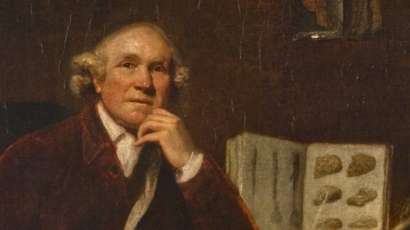السرطان اليوم ،، وقبل 200 عام ،ما الذي تغير في الطب وفي المرض

أكد اطباء بريطانيون التشخيص الذي توصل اليه قبل اكثر من 200 عام احد اكثر الجراحين علما ونفوذا.
وكان الجراح جون هانتر شخص اصابة احد مرضاه في عام 1786 بورم وصفه بأنه “صلب كالعظام.”
وقام اطباء يعملون في مستشفى مارسدين الملكي للاورام بتحليل العينات التي اخذها هانتر وملاحظاته الطبية التي يحتفظ بها في متحف يحمل اسم الجراح الشهير في لندن.
إعلان
واضافة الى تأكيد تشخيص هانتر، يعتقد الفريق الطبي المتخصص بالسرطانات ان العينات التي اخذها هانتر قد تعطي فكرة عن عملية تغير مرض السرطان عبر العصور.
وقالت الطبيبة كريستينا ماسيو لبي بي سي “بدأت هذه الدراسة كعملية استكشاف غرضها المتعة لا غير، ولكننا دهشنا بنفاذ بصيرة هانتر وفطنته.”
يذكر ان هانتر عين جراحا خاصا للملك جورج الثالث في عام 1776، ويعد احد الجراحين الذين لهم الفضل بتحويل الجراحة من شيء يشبه الجزارة الى علم حقيقي.
ويقال إنه اصاب نفسه عمدا بمرض السيلان على سبيل التجربة عندما كان يكتب كتابا حول الامراض الزهرية والتناسلية.

الملك جورج الثالث كان احد المرضى الذين يعالجهم جون هانتر
ويحتفظ متحف هانتر الملحق بكلية الجراحين الملكية البريطانية بمجموعة عيناته وملاحظاته ومؤلفاته الكبيرة.
وتضم هذه المجموعة ملاحظاته المسهبة التي تصف احداها رجلا راجع مستشفى القديس جورج في عام 1766 وهو يشتكي من ورم صلب في اسفل احد فخذيه.
وجاء في الملاحظات “بدا لأول وهلة بأنه ورم في العظم، وكان ينمو بسرعة كبيرة جدا. وعند فحص العضو المصاب، توصلنا الى انه مكون من مادة تحيط بالجزء السفلي من عظم الفخذ، وكان يبدو وكأنه ورم نشأ من العظم نفسه.”
وقام هانتر ببتر فخذ المريض مما ادى الى تماثله مؤقتا لاربعة اسابيع.
“,لكن بعد ذلك، بدأ يضعف ويضمحل تدريجيا واصبح يعاني من ضيق في التنفس.”
ومات المريض بعد عملية البتر بـ 7 اسابيع، وكشف تشريح جثته عن انتشار الاورام الشبيهة بالعظام الى رئتيه وشغاف قلبه واضلاعه.
وبعد مضي اكثر من 200 عام على ذلك، اكتشفت الطبيبة ماسيو العينات التي اخذها هانتر.
وقالت “بمجرد النظر الى العينات، تيقنت ان المريض كان يعاني من سرطان العظام. لقد كان وصف جون هانتر حصيفا جدا ويتماشى مع ما نعرفه عن سير هذا المرض.”
ومضت للقول “إن الكميات الكبيرة من العظم المكون حديثا وشكل الورم الاولي تعتبر من الخصائص المميزة لسرطان العظام.”
واستشارت ماسيو زملاءها في مستشفى مارسدين الملكي الذين استخدموا سبل المسح الحديثة للتأكد من التشخيص.
وقالت الطبيبة المتخصصة بهذا النوع من السرطانات “اعتقد ان تشخيصه كان مثيرا للاعجاب وفي الحقيقة كان اسلوب العلاج الذي استخدمه مشابها لما نفعله في يومنا هذا.”
ولكنها قالت إن المرحلة المثيرة لهذه البحوث لم تبدأ بعد، إذ سيقوم الاطباء بمقارنة المزيد من العينات التي جمعها هانتر من مرضاه مع الاورام المعاصرة – مجهريا وجينيا – للاستدلال عن وجود اي فروق بينها.
وقالت ماسيو لبي بي سي “إنها دراسة تتناول تطور السرطانات في السنوات الـ 200 الاخيرة، واذا كنا صادقين مع انفسنا يجب علينا القول إننا لا نعلم ما الذي سنتوصل اليه.”
“ولكنه سيكون من المثير للاهتمام ان نرى ان كنا نتمكن من ربط عوامل الخطورة المتأتية عن اساليب الحياة مع اي فروق قد نراها بين السرطانات التاريخية والمعاصرة.”
واعتذر فريق مستشفى مارسدين الملكي في مقال نشروه في النشرة الطبية البريطانية عن تأخرهم في تحليل العينات من عام 1786 الى يومنا هذا وانتهاكهم لقواعد تأخر علاج الامراض السرطانية، ولكنهم نوهوا الى ان مستشفاهم لم يفتتح بعد مدة طويلة.
المصدر: وكاله الانباء البريطانية






